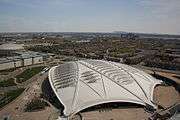Montreal Biodome
|
View from the tower of the Olympic Stadium | |
| Date opened |
April 1976 (Velodrome)[1] June 19, 1992 (Biodome)[2] |
|---|---|
| Location |
4777, avenue Pierre-de Coubertin Montreal, Quebec, Canada H1V 1B3 |
| Coordinates | 45°33′35″N 73°32′59″W / 45.55972°N 73.54972°WCoordinates: 45°33′35″N 73°32′59″W / 45.55972°N 73.54972°W |
| No. of animals | 4802 (excluding invertebrates), 1500 Plants |
| No. of species | 229 (excluding invertebrates), 750 Plants |
| Annual visitors | 815,810 (2011)[3] |
| Memberships | AZA,[4] CAZA[5] |
| Website |
espacepourlavie |

The Montreal Biodome (French: Biodôme de Montréal) is a facility located at Olympic Park in the Montreal neighbourhood of Mercier–Hochelaga-Maisonneuve that allows visitors to walk through replicas of four ecosystems found in the Americas. The building was originally constructed for the 1976 Olympic Games as a velodrome. It hosted both track cycling and judo events. Renovations on the building began in 1989 and in 1992 the indoor nature exhibit was opened.
The Montreal Biodome is one of four facilities that make part of the largest natural science museum complex in Canada, Space for Life, which also includes the Montreal Insectarium, Montreal Botanical Garden, and Rio Tinto Alcan Planetarium.[6] It is an accredited member of both the Association of Zoos and Aquariums (AZA) and the Canadian Association of Zoos and Aquariums (CAZA).[7]
History
The building was designed by French architect Roger Taillibert as part of his larger plan for an Olympic park that included the Montreal Olympic Stadium and the Olympic pool.[8] The venue was a combined velodrome and Judo facility. Construction of the building began in August 1973, and the facility was officially opened in April 1976.[1]
In 1988, a feasibility study was conducted for converting the velodrome into a biodome. Construction started in 1989, and the facility was opened to the public on 18 June 1992 as the Montreal Biodome.[2]
In the summer of 2003, the Biodome installed an audio guide system that lets visitors get information about what they are viewing, and also provides statistics to the facility about what the visitors find most interesting. Visitors can rent a receiver programmed to receive French, Spanish, or English for adults, or French or English for children.[7]
Exhibits
The facility allows visitors to walk through replicas of four ecosystems found in the Americas:
- The Tropical Forest is a replica of the South American rainforest.
- The Laurentian Forest is a replica of the North American wilderness.
- The Saint Lawrence Marine Eco-system is an estuary habitat modelled on the Gulf of Saint Lawrence.
- The Sub-Polar Region is a habitat that is divided into Arctic and Antarctic.
All the exhibits are housed inside the former velodrome (cycling stadium) that was used for the cycling and judo events of the 1976 Summer Olympics, with each of the four environments taking up a portion of the stadium. A variety of animals live in each simulated habitat, ranging from the macaws in the Tropical Forest, to the lynx in the Laurentian Forest, to the penguins in the Antarctic and the different kinds of fish that inhabit the waters of the Saint Lawrence River. As well, two new species have been discovered living in the Biodome: the acarian Copidognathus biodomus in the simulated estuary in 1996,[7][9] and the bacterium Nitratireductor aquibiodomus in the water reprocessing system in 2003.[10]
Renovation
On October 2015, it was announced that both the Biodome and the Insectarium would be closing their doors to the public from September 2016 to December 2017, in order to receive a facelift, as part of one of the many ways to celebrate the city of Montreal's 375th anniversary.[11]; however, in August 2016, the mayor of Montreal cancelled the contract to renovate the Biodome, because the bid results received by the city were much higher than the initial estimates[12]. The facelift project went back to a bidding process, and the Biodome will continue to be open to the public through 2017.
Biosphère
The Biodome should not be confused with the Biosphère, a Montreal museum about the St. Lawrence river located inside the geodesic dome that once housed the American pavilion for Expo 67. The Biodome, in contrast, is neither spherical nor a geodesic dome, and was once called the Velodrome, as it housed the 1976 Olympic cycling events. The Biodome was not an animal and plant conservation/research centre until 1992.
Gallery
 The Biodome, in front of the Olympic Stadium
The Biodome, in front of the Olympic Stadium View from above
View from above- Inside the Biodome (polar area)
- Some penguins in the polar area
See also
- Bio-Dome, the film
- Biosphere 2, the attempt to create a self-contained ecological system
- Olympic Stadium (Montreal)
References
- 1 2 1976 Summer Olympics official report. Volume 2. pp. 76-85.
- 1 2 "Trevel Guide: One-day Through the Americas" (PDF). ville.montreal.qc.ca. Montreal Nature Museums. Retrieved 31 August 2010.
- ↑ "Bilan 2011" (PDF). Tourisme Montréal. Retrieved 24 May 2013.
- ↑ "List of Accredited Zoos and Aquariums". aza.org. Association of Zoos and Aquariums. Retrieved 31 August 2010.
- ↑ "Members' Directory, Accredited Institution". caza.ca. Canadian Association of Zoos and Aquariums. Retrieved 31 August 2010.
- ↑ "About Us". ville.montreal.qc.ca. Montreal Nature Museums. Retrieved 30 August 2010.
- 1 2 3 "Biodome, and Oasis in the Heart of the City" (PDF). sennheiser.com. Sennheiser electronic GmbH & Co. KG. January 2004. pp. 26, 27. Retrieved 30 August 2010.
- ↑ 1976 Summer Olympics official report. Volume 2. pp. 13.
- ↑ "Scientific Research". ville.montreal.qc.ca. Montreal Nature Museums. Retrieved 31 August 2010.
- ↑ "Nitratireductor aquibiodomus gen. nov., sp. nov., a novel -proteobacterium from the marine denitrification system of the Montreal Biodome (Canada)". sgmjournals.org. International Journal of Systemic and Evolutionary Microbiology. Retrieved 30 August 2010.
- ↑ http://www.cbc.ca/news/canada/montreal/biodome-and-insectarium-closed-renovations-1.3262780
- ↑ http://montrealgazette.com/news/local-news/mayor-puts-biodome-project-on-ice-after-contract-bids-come-in-at-double-the-estimate
External links
| Wikimedia Commons has media related to Montreal Biodome. |
- Official website
- Space for Life Foundation home page
- The Glass Ark, a National Film Board of Canada documentary

_pictogram.svg.png)
